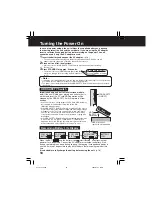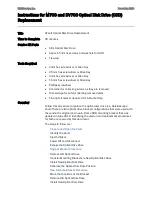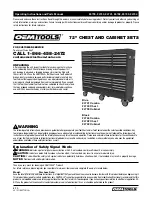
9
B
e
fore Use
Operating Precautions
Card Data Protection
(Refer to page 10 for details on compatible cards.)
• Do not unplug the AC adaptor or disconnect the USB cable connecting a PC while this unit is in
operation.
• Do not remove the card while it is being accessed.
• Be sure the card does not contain important data before formatting it. Formatting irreversibly
deletes all data stored on the card.
• Do not touch the terminals on the back of the Memory Card.
• Electrical interference, electrostatic discharges and malfunctions of the unit or card may all result
in damage to the card or data loss. It is recommended that any important data also be backed up
on a PC.
• Stored data should be periodically backed up as a protection against data corruption, data loss
or device malfunction. Please note that our company shall not accept any liability for damage or
loss of stored data.
• SD Memory Cards, Memory Sticks, Smart Media Cards and some CF Cards (when a PC Card
Slot is used) include a write-protect switch. When this switch is set to the “LOCK” position, it will
not be possible to write data to or delete data from the Memory Card or format Memory Card.
Handling the PC Card HDD
The PC Card HDD is a very small, high-precision hard disk drive. Be particularly careful when
handling this drive. Strictly observe the following to avoid HDD malfunction, damage, or data
loss.
• Do not subject the PC Card HDD to excessive vibration and strong impacts.
• Do not use the unit in areas of extreme temperature differences (where temperature changes
more than 15 °C in one hour). If the unit is suddenly moved from a cold place to a warm place or
vice versa, or if a room is quickly heated in wintertime or quickly cooled in summertime, or if a
cooler blows directly on the unit, etc., condensation (dew) may form. Using the unit in this
condition may cause serious damage to the HDD. If condensation occurs, turn the unit power off
and remove the PC Card HDD. Then leave this way for about 4 hours until the ambient
temperature equalizes. After confirming condensation is no longer present, you may use the unit.
• Do not twist the PC Card HDD or press down on the label surface, and do not write on the PC
Card HDD using a pen with a hard tip, as these actions may damage the PC Card HDD. When
holding the PC Card HDD, always hold it by the outside edges.
• Do not remove the label that is attached to the PC Card HDD. If this label is removed, you may
not be eligible for warranty service or other services.
• Before removing the PC Card HDD from its special carrying case, make sure that the side of the
case labeled “PC Card HDD” is facing upward. If the case cover is opened and the labeled side
is not facing upward, the PC Card HDD may fall out and be damaged.
• Always use the special carrying case to carry the PC Card HDD.
• Please note that our company shall not accept any liability for damage or loss of data stored within
the PC Card HDD due to inappropriate handling.
ScanDisk
(“CheckDisk” for Windows 2000/XP users)
• Do not subject the PC Card HDD to excessive vibration or strong impacts. Also, do not turn off
the power supply or remove the card from the unit while it is in operation, otherwise data may be
corrupted. If a problem occurs, immediately use the computer’s ScanDisk/CheckDisk function to
check the media contents. (It takes several hours for ScanDisk/CheckDisk to finish checking the
PC Card HDD.) It is recommended that you then make a backup of the data on the media. See
page 42 on how to connect the unit to a computer. Refer to your computer manual regarding
ScanDisk/CheckDisk function.
PT1.p6-9.p65
2003/01/14, 12:36
9










































